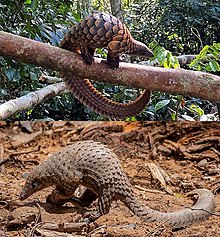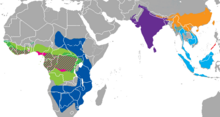Phataginus
| African tree pangolin | |
|---|---|

| |
| Pangolins from genusPhataginus | |
| Scientific classification | |
| Domain: | Eukaryota |
| Kingdom: | Animalia |
| Phylum: | Chordata |
| Class: | Mammalia |
| Order: | Pholidota |
| Family: | Manidae |
| Subfamily: | Phatagininae Gaubert, 2017 |
| Genus: | Phataginus Rafinesque,1821 |
| Type species | |
| Manis tetradactyla Linnaeus,1766
| |
| Species | |

| |
| Synonyms[2][3] | |
|
synonyms of subfamily:
synonyms of genus:
| |
African tree pangolin(Phataginus) is a genus of Africanpangolinsfrom subfamilysmall African pangolins(Phatagininae), within familyManidae.[5]Its members are the morearborealof the African pangolins.[6]
The number of illegally trafficked pangolins from genusPhataginuswere at least a shocking 895,000 from the years 2010 to 2019. The animal is hunted and poached for its scales and meat and is often used for the making of traditional medicine in places such asChinaandVietnam.Attempts are still being made to help protect these mammals from trafficking and extinction, unfortunately their slow reproduction rate isn't much of assistance to this effort. Currently thetree pangolinis listed as vulnerable. All of the pangolins species have been listed as vulnerable, endangered and critically endangered.[7]
Etymology[edit]
Constantine Rafinesque(1821) formed the Neo-Latin generic namePhataginusfrom the French termphatagin,adopted byCount Buffon(1763) after the reported local namephataginorphatagenused in theEast Indies.
Taxonomy[edit]
- Subfamily:Phatagininae(small African pangolins)
- Genus:Phataginus(African tree pangolin)
- Phataginus tetradactyla(Long-tailed pangolin)
- Phataginus tricuspis(Tree pangolin)
- Genus:Phataginus(African tree pangolin)
Phylogeny[edit]
Phylogenetic position of genusPhataginuswithin family Manidae.[8][9][1]
| Pholidotamorpha |
| |||||||||||||||||||||
(Pholidotasensu lato)
|
References[edit]
- ^abPhilippe Gaubert, Agostinho Antunes, Hao Meng, Lin Miao, Stéphane Peigné, Fabienne Justy, Flobert Njiokou, Sylvain Dufour, Emmanuel Danquah, Jayanthi Alahakoon, Erik Verheyen, William T Stanley, Stephen J O’Brien, Warren E Johnson, Shu-Jin Luo (2018)The Complete Phylogeny of Pangolins: Scaling Up Resources for the Molecular Tracing of the Most Trafficked Mammals on Earth
- ^"Manidae".
- ^https://www.pangolinsg.org/wp-content/uploads/sites/4/2016/06/Heath-1992-Manis-Pentadactyla.pdf[bare URL PDF]
- ^"Taxonomic Swap 25736".iNaturalist.2017-10-08.Retrieved2019-09-17.
- ^Schlitter, D.A. (2005)."Order Pholidota".InWilson, D.E.;Reeder, D.M (eds.).Mammal Species of the World: A Taxonomic and Geographic Reference(3rd ed.). Johns Hopkins University Press. p. 531.ISBN978-0-8018-8221-0.OCLC62265494.
- ^du Toit, Z.; du Plessis, M.; Dalton, D. L.; Jansen, R.; Paul Grobler, J.; Kotzé, A. (2017)."Mitochondrial genomes of African pangolins and insights into evolutionary patterns and phylogeny of the family Manidae".BMC Genomics.18(1): 746.doi:10.1186/s12864-017-4140-5.PMC5609056.PMID28934931.
- ^Gaubert, P. (2020). "Development and characterization of 20 polymorphic microsatellite markers for the white-bellied pangolinPhataginus tricuspis(Mammalia, Pholidota). Molecular Biology Reports., 47(6), 4827–4833.https://doi.org/10.1007/s11033-020-05511-6
- ^Gaudin, Timothy (2009)."The Phylogeny of Living and Extinct Pangolins (Mammalia, Pholidota) and Associated Taxa: A Morphology Based Analysis"(PDF).Journal of Mammalian Evolution.16(4). Heidelberg, Germany: Springer Science+Business Media: 235–305.doi:10.1007/s10914-009-9119-9.S2CID1773698.Archived fromthe original(PDF)on 2015-09-25.Retrieved2020-12-20.
- ^Kondrashov, Peter; Agadjanian, Alexandre K. (2012). "A nearly complete skeleton ofErnanodon(Mammalia, Palaeanodonta) from Mongolia: morphofunctional analysis ".Journal of Vertebrate Paleontology.32(5): 983–1001.doi:10.1080/02724634.2012.694319.ISSN0272-4634.S2CID86059673.
